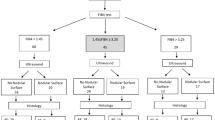Abstract
Purpose
This study was performed to elucidate whether evaluating the liver surface, edge, and texture by high-resolution ultrasonography is useful for predicting the occurrence of hepatocellular carcinoma (HCC) in patients with hepatitis C virus (HCV)-associated chronic liver diseases (CLDs)
Methods
The integrated fibrosis stage (a comprehensive value of scores for liver edge, surface, and texture) of 337 patients with HCV-associated CLDs was evaluated, at entry, by ultrasonography (US), as a US score. The patients were followed up prospectively (mean observation period was 16.4 months; range 2.8–36.2 months) for the occurrence of HCC by US or helical CT at 3-month intervals. A total of 140 patients received interferon therapy, and the occurrence of HCC was compared between those with and without interferon therapy
Results
The annual incidence of HCC was 1.1, 5.5, and 10.2% in low, middle, and high US score groups, respectively. Univariate analysis showed that age, serum levels of total bilirubin, alpha-fetoprotein (AFP), platelet count, albumin, total cholesterol, and the US score were associated with HCC occurrence in the patients. A multivariate proportional hazard model revealed that only the middle and high US scores (p = 0.0922, hazard ratio 4.006, 95% CI 0.796–20.153 and p = 0.008, hazard ratio 7.991, 95% CI 1.721–37.10, respectively) and elevated AFP (p = 0.031, hazard ratio 2.774, CI 1.097–7.014) were independently associated with HCC occurrence. Our US scoring based on evaluation of the liver surface, edge, and texture was clearly and strongly associated with the occurrence of HCC in patients with HCV-associated CLDs, and with the higher occurrence rate of HCC in patients with higher US scores
Conclusion
Thus, US is a good tool for evaluating the fibrosis stage of the liver, and may therefore be useful in designing an optimum follow-up interval for each patient with HCV-associated CLD.




Similar content being viewed by others
References
Ikeda K, Saitoh S, Suzuki Y, et al. Disease progression and hepatocellular carcinogenesis in patients with chronic viral hepatitis—a prospective observation of 2215 patients. J Hepatol. 1998;28:930–8.
Tsukuma H, Hiyama T, Tanaka S, et al. Risk factors for hepatocellular carcinoma among patients with chronic liver disease. N Engl J Med. 1993;328:1797–801.
Ikeda K, Saitoh S, Koida I, et al. A multivariate analysis of risk factor for hepatocellular carcinogenesis—a prospective observation of 795 cases with viral and alcoholic cirrhosis. Hepatology. 1993;18:47–53.
Simonetti RG, Camma C, Fiorello F, et al. Hepatitis C virus infection as a risk factor for hepatocellular carcinoma in patients with cirrhosis. A case–control study. Ann Intern Med. 1992;116:97–102.
Yoshida H, Shiratori Y, Moriyama M, et al. Interferon therapy reduces the risk for hepatocellular carcinoma: national surveillance program of cirrhotic and noncirrhotic patients with chronic hepatitis C in Japan. IHIT Study Group. Inhibition of Hepatocarcinogenesis by Interferon Therapy. Ann Intern Med. 1999;131(3):174–81.
Hung C-H, Lu SN, Wang JH, et al. Correlation between ultrasonographic and pathologic diagnoses of hepatitis B and C virus-related cirrhosis. J Gastroenterol. 2003;38:153–7.
Khan KN, Yamasaki M, Yamasaki K, et al. Proposed abdominal sonographic staging to predict severity of liver diseases: analysis with peritoneoscopy and histology. Dig Dis Sci. 2000;45:554–64.
Gaiani S, Gramantieri L, Venturoli N, et al. What is the criterion for differentiating chronic hepatitis from compensated cirrhosis? A prospective study comparing ultrasonography and percutaneous liver biopsy. J Hepatol. 1997;27:979–85.
Simonovsky V. The diagnosis of cirrhosis by high resolution ultrasound of the liver surface. Br J Radiol. 1999;72:29–34.
Ferral H, Male R, Cardiel M, et al. Cirrhosis: diagnosis by liver surface analysis with high-frequency ultrasound. Gastrointest Radiol. 1992;17:74–8.
Nishiura T, Watanabe H, Ishibashi H, et al. Ultrasound evaluation of the fibrosis stage in chronic liver disease by the simultaneous use of low and high frequency probes. Br J Radiol. 2005;78:189–97.
Moriya K, Fujie H, Shintani Y, et al. The core protein of hepatitis C virus induces hepatocellular carcinoma in transgenic mice. Nat Med. 1998;4:1065–7.
Niederau C, Lange S, Heintges T, et al. Prognosis of chronic hepatitis C: results of a large, prospective cohort study. Hepatology. 1998;28:1687–95.
Nishiura T, Watanabe H, Ishibashi H, et al. Efficacy of the Liver US Score for the discrimination of early-stage cirrhosis (F4) from advanced-stage chronic hepatitis (F3). Jpn J Med Ultrasonics. 2006;33(6):655–63.
Degos F, Christidis C, Ganne-Carrie N, et al. Hepatitis C virus related cirrhosis: time to occurrence of hepatocellular carcinoma and death. Gut. 2000;47:131–6.
Tarao K, Rino Y, Ohkawa S, et al. Association between high serum alanine aminotransferase levels and more rapid development and higher rate of incidence of hepatocellular carcinoma in patients with hepatitis C virus-associated cirrhosis. Cancer. 1999;86:589–95.
Kasahara A, Hayashi N, Mochizuki K, et al. Risk factors for hepatocellular carcinoma and its incidence after interferon treatment in patients with chronic hepatitis C. Osaka Liver Disease Study Group. Hepatology. 1998;27(5):1394–402.
Castéra L, Vergniol J, Foucher J, et al. Prospective comparison of transient elastography, fibrotest, APRI, and liver biopsy for the assessment of fibrosis in chronic hepatitis C. Gastroenterology. 2005;128:343–50.
Vizzutti F, Arena U, Marra F, et al. Elastography for the non-invasive assessment of liver disease: limitations and future developments. Gut. 2009;58:157–60.
Author information
Authors and Affiliations
Corresponding author
About this article
Cite this article
Nishiura, T., Watanabe, H., Yano, K. et al. Integrated fibrosis scoring by ultrasonography predicts the occurrence of hepatocellular carcinoma in patients with chronic hepatitis C virus infection. J Med Ultrasonics 38, 13–19 (2011). https://doi.org/10.1007/s10396-010-0285-4
Received:
Accepted:
Published:
Issue Date:
DOI: https://doi.org/10.1007/s10396-010-0285-4




